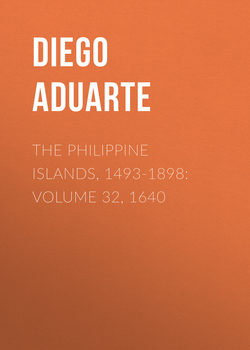Читать книгу The Philippine Islands, 1493-1898: Volume 32, 1640 - Aduarte Diego - Страница 16
Book Second of the History of the Province of the Holy Rosary
Chapter V
The election as provincial of father Fray Melchior Mançano, and the situation in Japon at this time
ОглавлениеWhen the sad news of the death of the provincial was learned, the electors assembled at Binalatongan, a village of Pangasinan, on the fifteenth of April, 1617, and elected as head and superior of the province father Fray Melchior de Mançano,14 who was at that time vicar of the convent of the city of Nueva Segovia. He was a very prudent and devout character, a professed son of the convent of the order in Ocaña; and had been made, on account of his great ability and his successful studies, a theologue at the college of Sancto Thomas at Alcala. In this province he had governed many of the best convents with great approbation; and his term as provincial was very useful to the province, augmenting it greatly, as will be narrated.
[Now that the churches in all Japon were torn down and all the priests expelled, as Safioye supposed, it seemed to him time to begin the persecution of Christianity. The commencement was made in the kingdom of Arima, which was under the direct government of the emperor. The officers upon whom was laid the carrying out of this persecution did their work with cruelty and insolence. When the news of the beginning of the persecution reached Figen, twenty courageous Japanese went from Nangasaqui to Arima to confess the faith, and died a glorious martyrdom. Some others who purposed to follow in their footsteps had not the courage, and recanted when they saw the dreadful torment which awaited them. As soon as father Fray Thomas del Espiritu Sancto, or Zumarraga, the vicar-provincial of our religious who were in hiding, heard of this persecution in Arima, he despatched father Fray Jacintho Orfanel to go to the aid of the persecuted Christians, and soon afterward sent father Fray Juan de Los Angeles Rueda to go thither also. They were followed by the father commissary of the Order of St. Francis, with three other religious of his order. The efforts of the religious in hearing confessions, giving the sacraments, and comforting and strengthening the persecuted Christians, were of great value. It seemed unwise, however, to enter the city of Arima itself, where guards had been set to prevent entrance and egress; for if the emperor should learn that any religious had remained in Japon, the persecution was likely to be very much more severe. The Christians in Nangasaqui prepared themselves, and were prepared by the religious, for the beginning of the persecution in that city. When everything was ready, the persecution was suspended on account of a war between the emperor and Fideyori, the son of the previous emperor and the true heir to the throne.15 The officers contented themselves with publicly burning a great number of rosaries, crosses, and other Christian emblems taken from Arima. Father Fray Alonso Navarrete had assumed the dress of a Spanish layman and was beaten for trying to rescue from the fire some rosaries. Our religious obtained the sacred relics of a number of the blessed martyrs. The emperor was victorious over Fideyori by treachery. During the progress of the war the Christians had peace; and the fathers did a mighty work in strengthening their courage, and in perfecting them in the faith. Many, however, of the Christians, for the lack of ministers, had begun to forget the matters of the faith and even their own Christian names. Some of the Franciscan fathers were captured, and thrown into prison; but the fathers of our order escaped. After the fall of Usaca and the disastrous close of the war, the persecution broke out again. The fathers were scattered among various kingdoms, but were prevented, by the very close watch which was kept, from entering Satzuma. The father vicar-provincial alone, with father Fray Francisco de Morales and father Fray Joseph, remained in Nangasaqui, going out at night only, in secular dress. This lasted until the death of the emperor, in the year 1616. Nangasaqui being the metropolis of Christianity in Japon, where the number of Christians was greatest and their spirit resolved and determined, the emperor did not dare to treat the Christians there with as much severity as elsewhere. In spite of the exposure of our ministers in Japon, not one of the members of our order died a natural death, but all were crowned with the crown and aureole of martyrdom.]
14
Melchor Manzano came to Manila in 1606, and ministered in the Cagayán missions until he was chosen provincial in 1617. In 1621 he was appointed procurator of the province at Madrid; and he died in Italy, about 1630, as bishop-elect of Nueva Segovia.
15
After the battle of Sekigahara (1600) Iyeyasu had left Hideyori (the infant son of Hideyoshi), with his mother, in the castle of Osaka. After this child grew to manhood, he incurred the jealousy of Iyeyasu, which was doubtless aggravated by his intimacy with the Jesuits, and the shelter given by him to many discontented Japanese, both heathen and Christian. Armies were raised on both sides, and on June 4, 1615, the castle of Osaka was carried by assault, and burned, Hideyori and his mother both perishing. See Murdoch and Yamagata’s full account of this war, its causes, and its immediate results (Hist. Japan, pp. 507–567); cf. Rein’s Japan, p. 306.
